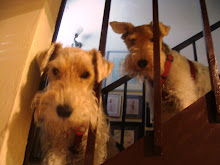
One of our very favorite and really smart dog gurus from Texas shared this note about dogs' noses.
Not to brag or anything, please read the part highlighted in red. The link to the article is at the end.
Jake and Just Harry
The World According to a Dog's Nose Article #1388by Ned Rozell
This column is provided as a public service by the Geophysical Institute, University of Alaska Fairbanks, in cooperation with the UAF research community. Ned Rozell is a science writer at the institute.
A dog can tell you a lot about the outdoors. When Jane, my Lab, vacuums the ground with her nose and her tail moves like a helicopter blade, I know a grouse is about to fly. When Jane stops as abruptly as a dragonfly, then runs off sniffing an invisible path, I know a snowshoe hare has crossed our trail.
All this entertainment is courtesy of that most sensitive appendage, a dog's nose. It's an instrument man has not been able to duplicate. A local search-and-rescue group, PAWS, uses dogs to find lost people, dead people, and people buried under earth and snow. Dogs have also been used to find gas leaks and the presence of gypsy moth egg sacks. A researcher here at the University of Alaska Fairbanks even wants to train a dog to find tiny wood frogs hibernating in the duff.
Lurking behind those textured, damp nostrils are sensitive membranes that allow a dog to distinguish smells--molecules of odor that emanate from every living or once-living thing--at least one thousand times better than humans. A dog processes odoriferous molecules more readily because a dog has a much larger set of scent membranes within its nose, explained Robert Burton in his book, The Language of Smell. While humans have a pair of these "olfactory receptors" in our noses each about the size of a postage stamp, dogs' receptors can be as large as a handkerchief, depending on how big the dog is.
Dogs noses work much the way ours do: We inhale molecules of odor, which then dissolve in mucus. The dissolved odors are picked up by the olfactory receptors, located behind where sunglasses rest on the nose. An organ called the olfactory bulb shunts the chemical messages straight to the part of the brain that deals with stored feelings and memories, bypassing the cerebral cortex, the main part of the brain. This short-circuit is one reason smells so rapidly trigger strong emotions and memories that may have lain dormant for years.
With its larger olfactory membranes, a dog's nose does amazing things. Researchers at Duke University found that a randomly selected fox terrier could after three weeks detect the scent of a fingerprint on a glass slide when compared to four clean slides. When the researchers placed the slides outside in the rain and dust, the dog was still able to pick out the slide with the fingerprint after 24 hours of weathering.
Dogs have fantastic tracking ability because humans leave a pretty good scent trail. Most researchers think the scent trails consists of "rafts," tiny bits of skin cells that have an odor when mixed with sweat and fed upon by bacteria. Because the human body sheds about 50 million cells each minute, rafts fall from the body like a shower of microscopic confetti. Dogs quickly detect these rafts, as well as other scents that may not be apparent to the producer, including breath and sweat vapor. Each person's scent trail is unique, and dogs are remarkably good at separating one person's trail from another's.
In an experiment performed a century ago, G. J. Romanes lined up 11 men behind him. He started walking, with each man walking precisely in his footsteps. After they walked 200 yards, the men dispersed, with five going to the right, six to the left. All the men hid. Another person released Romanes' dog, who found Romanes almost instantly after hesitating slightly where the men separated.
Seventy years after Romanes' study, H. Kalmus performed a similar test using identical twins. The twins must have had quite similar scents, Kalmus reported: "if the dog was given the scent of one twin, it would happily follow the other." When both twins were used in the experiment, however, the dog was able to pick one from the other. What a great tool a dog's nose is--it rarely malfunctions and the body it's attached to is always happy to see you.
http://www.gi.alaska.edu/ScienceForum/ASF13/1388.html

















8 comments:
Yeah, us fox terriers have probiscii that rival that of Jimmy Durante! That is why we are so good at smelling stuff!~ Like whatever muzzer is cooking in the kitchen!!!!
That's why we can smell hamberg cooking a mile away!! We tagged you go look!! Love A+A
And some Texas dogs have a nose for news. Would that be Tribby who is scanning the wires?
What's amazing is that the researchers are surprised by the power of a dog's nose. Are we surprised by their lack of awareness?
No.
Wow, you guys should work for CSI!
Poppy
It's so true abut the nose part except I'm no fox terrier. Hehe.
Snuggle,
Precious
See you're living up to the INTELLIGENT - SMART side of WFT nature, with this interesting academic post.
Re the nose thing - you two would have a field day in my garden fox hunting...
Pats to you both
Blue
We DO have good sniffers, and I'm going to show this to Dad the next time he calls me pencil-nose. All the better to smell with, deary!
William Tell
That's fantastic! Thank you, Jake!! I always knew this nose was more than just cute!
Koobuss Kisses,
Koobie
Post a Comment